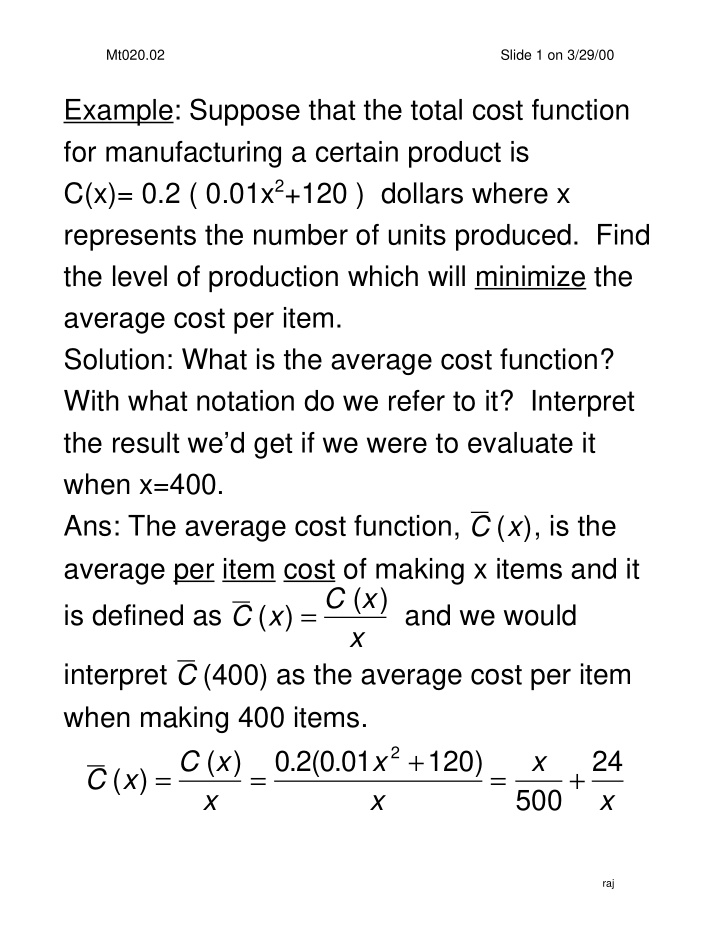



Mt020.02 Slide 1 on 3/29/00 Example: Suppose that the total cost function for manufacturing a certain product is C(x)= 0.2 ( 0.01x 2 +120 ) dollars where x represents the number of units produced. Find the level of production which will minimize the average cost per item. Solution: What is the average cost function? With what notation do we refer to it? Interpret the result we’d get if we were to evaluate it when x=400. Ans: The average cost function, C ( x ), is the average per item cost of making x items and it is defined as C ( x ) = C ( x ) and we would x interpret C (400) as the average cost per item when making 400 items. = 0.2(0.01 x 2 + 120) C ( x ) = C ( x ) 500 + 24 x = x x x raj
Mt020.02 Slide 2 on 3/29/00 and so if we computed C (400) we’d have C (400) = 400 500 + 24 400 = 0.86 or, 86 cents per item, on the average for each of the first 400 items. So our objective function (the function to be 500 + 24 x optimized) is C ( x ) = x and we need to provide a restricted, “real world” domain from which the values of x may be obtained. What is the model’s domain? ---------- (0, ∞ ) . Our comforting fact is not available to guarantee a result, the domain interval isn’t closed. Still we can proceed and find critical points. 500 − 24 1 x 2 and C ' ' ( x ) = 48 C ' ( x ) = x 3 . Notice that the second derivative is >0 on our domain. raj
Mt020.02 Slide 3 on 3/29/00 This says that it is always concave up for the x values in which we are interested. Note too that across our model domain, the first derivative is defined everywhere (0 is not allowed in our domain!) Setting the derivative equal to zero and solving we get that x 2 =(24)(500) so x=109.54 is the only useful critical point for us. That is where the minimum value occurs. Check it with your calculator. Example: When organic waste is dumped into a pond, the oxidation process that takes place reduces the pond’s oxygen content. However, given time, nature will restore the oxygen content to its natural level. Suppose the oxygen content t days after organic waste has been dumped into the pond is given by the function: raj
Mt020.02 Slide 4 on 3/29/00 f ( t ) = 100 t 2 − 4 t + 4 (0 ≤ t < ∞ ) percent of t 2 + 4 its normal level. a) When is the level of oxygen content lowest? b) When is the rate of oxygen regeneration greatest? Solution: a) We are being asked to minimize the function f ( t ) = 100 t 2 − 4 t + 4 on the t 2 + 4 interval [0, ∞ ). Our function is continuous on our interval, but the interval is NOT closed. Hmm.... Differentiation the function f(t) and cleaning up we find that f ' ( t ) = 400( t 2 − 4) ( t 2 + 4) 2 . We notice that this derivative exists for all of our values of t. (No tricky critical points). This derivative is raj
Mt020.02 Slide 5 on 3/29/00 zero for t = ± 2, but we can eliminate t = -2 as out of bounds for our situation. Throw in our endpoint as a possible location for an extreme value and we get that f(0)=100 (oxygen is at 100% of its normal level at t=0, when the waste is dumped) and f(2)=0 (there is absolutely no oxygen two days after the dumping). Can’t go any lower than that. Look closely at the definition of f(t) and argue why we can say f(t) ≥ 0 for any t. f ( t ) = 100 t 2 − 4 t + 4 (0 ≤ t < ∞ ) t 2 + 4 Observe the numerator is just (t-2) 2 , which is never negative. raj
Mt020.02 Slide 6 on 3/29/00 What about question b)? When is the oxygen returning fastest? We are being asked to maximize the rate at which oxygen is changing, i.e. we are being asked to maximize f’(t). To do that we must find the critical points of f’, and check them for max and min of f’ over our domain. The derivative of f’ is just f’’ which is f '' ( t ) = 800 t (12 − t 2 ) which is zero when t=0 ( t 2 + 4) 3 and when t = ± 12 = ± 2 3. Only the positive value interests us. Our two critical points of f’ are then t 1 =0 and t 2 = 12. To find which corresponds to the max of f’ evaluate: f’(t 1 ) = -100 and f’(t2) = 100/8 = 12.5, the obvious max. So twelve and a half days after raj
Mt020.02 Slide 7 on 3/29/00 the dumping, the oxygen is regenerating at the its maximal rate. raj
Recommend
More recommend